ONE THING YOU CAN SAY ABOUT OSH — IT ISN’T BISHKEK. It’s a dusty town on the border with Uzbekistan, ten hours by road or 45 air minutes and again we chose to fly. Once on the ground things began interestingly. Our disabled cab driver (muscular dystrophy?) was a pleasant guy and much liked by his fellow drivers. But he couldn’t find the Sunrise Hotel, not due to his disability, but because the hotel is hidden behind ongoing construction. It’s worth hunting for, however. The wifi is sporadic in all of Osh and TV is Russian only. But our suite is wonderful and the bathroom is almost as plush as those in Japan. Great breakfast, too.

Sunrise Hotel, worth the search
Osh was an important stop along the Silk Road, that network of trails, paths and passes that linked east and west for nearly 2000 years when caravans carried silk and other goods from Xian, China to Egypt. Few people, camels or goods ever traveled the entire route. Most worked only a section, stopping at places like Osh and Samarkand, exchanging their wares and returning, much like Pony Express riders would two thousand years later.
Silk wasn’t the only, or even the most important, thing carried along the Silk Road. The exchange of culture — art, religion, philosophy, techology, science, architecture and even language — spread westward along with commercial goods. And diseases, like the plague which arrived in Constantinople in 542, stowed away, too. When the Byzantine Empire fell in 1453 the Ottomans closed the Silk Road forcing merchants to find sea routes to the Orient.

Local ladies
There is little to be seen in Osh today of the Silk Road. Little to be seen of anything except the Sulaiman Too Sacred Mountain. (We had an AH-HA moment when we realized that Sulaiman and Solomon are cognate. It never crossed our minds when we were in Israel where both Solomon and Suleiman the Magnificent held court.) This UNESCO World Heritage site dominates the Fergana Valley and forms the backdrop to the city of Osh, at the crossroads of important routes on the Central Asian Silk Roads. For more than one and a half millennia, Sulaiman was a beacon for travellers and was revered as a sacred mountain. Yesterday we hiked around its five peaks and caves with the locals, enjoying the sunshine and spring flowers.

The Fanny Pack — Kate, Ali and Rebecca
The four sunburned young women were speaking real English, American English, at breakfast this morning. Well, Ali was — Rebecca, Kate and Lindsay are Canadians, eh. They had just returned from skiing the border area between Tajikistan, Afghanistan and China, studying the effects of fences on Marco Polo sheep migration, the same sheep we knew as argali in Mongolia. These ladies, known as the Fanny Pack, are the real deal. They are experienced mountaineers with some serious ascents in their CVs along with PhDs, awards and grants from prestigious scientific organizations. Two are fellow members of the Explorers Club. We are not in their league, of course, and it is great to know that others, younger and more talented than Connie and I, are also actively involved in conservation efforts. Check them out at www.borderski. com.